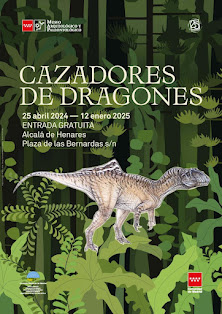Otro de los trabajos del GBE presentados durante las VIII Jornadas Internacionales sobre Dinosaurios y su Entorno en Salas de los Infantes fue “Updating the Iberian fossil record of Triassic Sauropterygia”, por Carlos de Miguel Chaves. Como el propio título del trabajo sugiere, en dicha presentación se hizo un repaso a la diversidad de este grupo de reptiles marinos mesozoicos durante el Triásico de la península ibérica, utilizando los más recientes descubrimientos y la revisión de ejemplares clásicos para llevar a cabo una puesta al día sobre este variado clado de animales.
Os dejamos a continuación el resumen de la comunicación presentada al congreso:
The origin and quick diversification of Sauropterygia, a successful clade of extinct Mesozoic aquatic reptiles, took place during the Triassic (Stubbs and Benton, 2016). Throughout this period, sauropterygians adapted to a wide disparity of lifestyles and trophic specializations, including herbivory, filter-feeding, durophagy and piscivory, some of them becoming apex predators, and inhabiting brackish waters, lagoons and open seas.
The fossil record of the Triassic sauropterygians is relatively abundant, spreading throughout Europe, Middle East, Asia, North of Africa and North America (see Rieppel, 2000). However, the record of this clade in the Iberian Peninsula has traditionally been poorly known when compared with those of other European areas (e.g., Germany, Italy), being composed by scarce, fragmentary and isolated remains, preventing detailed systematic attributions. Here, we carry out a review of recent studies on Triassic sauropterygians from the Iberian Peninsula, allowing an update in our knowledge on the diversity of these animals.
Placodontia is composed by durophagous members of Sauropterygia. The Iberian record has recently being increased with the description of a new taxon, Parahenodus atancensis (de Miguel Chaves et al., 2018a) and the identification of the genus Psephosauriscus, so far exclusive of the Middle East (de Miguel Chaves et al., 2018b). The genus Paraplacodus has also been identified based on an isolated rib (Pinna, 1990), but the putative identification of other placodont taxa cannot be currently confirmed due to the poorly informative nature of the remains attributed to them (de Miguel Chaves et al., 2018b).
The Iberian diversity of Nothosauroidea, a sauropterygian clade which includes large top predators, small piscivorous forms and filter feeders, has also increased in recent years with the description of the new taxa Hispaniasaurus cranioelongatus (Márquez-Aliaga et al., 2019) and Paludidraco multidentatus (de Miguel Chaves et al., 2018c). The nothosauroid record from the Iberian Peninsula also includes at least two different forms of the genus Nothosaurus, based on the morphology of isolated vertebrae (de Miguel Chaves et al., 2016), and two species of the genus Lariosaurus: Lariosaurus balsami (Rieppel and Hagdorn, 1998) and Lariosaurus calcagnii (Quesada and Aguera González, 2005).
Pistosauroids were a clade of Triassic sauropterygians that inhabited open waters and to which the plesiosaurs belong. This clade could be represented by a partial specimen of an indeterminate pistosauroid (Alafont and Sanz, 1996).
Finally, Pachypleurosauria is represented by several specimens of small forms among which there are some that could belong to a new taxon (under study) (Rieppel and Hagdorn, 1998; Fortuny et al., 2011). Thus, at least 11 different sauropterygian species can currently be identified in the Triassic record of the Iberian Peninsula. The update on these forms allows as to propose a synthesis relative to the knowledge about this group, new data being provided.
-----
Más información:
- Referencia: de Miguel Chaves, C., Ortega, F., Pérez-García, A. 2019. Updating the Iberian fossil record of Triassic Sauropterygia. Comunicación oral. Libro de resúmenes del VIII Jornadas Internacionales sobre Paleontología de Dinosaurios y su Entorno: 89.
- Imagen: el susodicho de Miguel durante un momento de su charla en las VIII Jornadas Internacionales de Dinosaurios y su Entorno.





























No hay comentarios:
Publicar un comentario